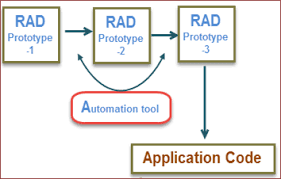Exploring the Significance of RAD in Modern Software Engineering Practices
The Importance of Rapid Application Development (RAD) in Software Engineering
Rapid Application Development (RAD) is a software development methodology that prioritizes rapid prototyping and quick feedback over long planning and testing cycles. RAD aims to accelerate the development process by focusing on iterative development and the creation of prototypes that can be quickly reviewed and modified.
Benefits of RAD:
- Speed: RAD allows for faster development cycles, enabling teams to deliver working software more quickly.
- Flexibility: The iterative nature of RAD allows for changes to be incorporated easily, even late in the development process.
- Customer Involvement: RAD encourages close collaboration with customers, leading to better alignment with their needs and expectations.
- Reduced Risk: By delivering working prototypes early, RAD helps identify potential issues sooner, reducing the risk of project failure.
- Cost-Effective: With its focus on efficiency and speed, RAD can help reduce development costs compared to traditional methodologies.
Key Principles of RAD:
- User Involvement: Users play a crucial role in the development process, providing feedback on prototypes and helping shape the final product.
- Rapid Prototyping: Creating quick prototypes allows stakeholders to visualize the end product early on and make informed decisions.
- Iterative Development: The project is divided into smaller iterations or sprints, with each iteration building upon the previous one.
- Cross-Functional Teams: RAD promotes collaboration among team members with diverse skills and expertise to ensure a holistic approach to software development.
In conclusion, Rapid Application Development (RAD) offers numerous benefits for software engineering projects by emphasizing speed, flexibility, customer involvement, reduced risk, and cost-effectiveness. By following key principles such as user involvement, rapid prototyping, iterative development, and cross-functional teams, organizations can leverage RAD to deliver high-quality software solutions efficiently and effectively.
Understanding RAD in Software Engineering: Key Principles, Benefits, and FAQs
- What is Rapid Application Development (RAD) in software engineering?
- How does RAD differ from traditional software development methodologies?
- What are the key principles of RAD in software engineering?
- What are the benefits of using RAD in software development projects?
- How does RAD facilitate faster delivery of working software?
- Why is user involvement important in RAD?
- Can RAD accommodate changes late in the development process?
- How does RAD help reduce risks associated with software development?
What is Rapid Application Development (RAD) in software engineering?
Rapid Application Development (RAD) in software engineering is a methodology that emphasizes quick prototyping, iterative development, and close collaboration with stakeholders to accelerate the software development process. RAD focuses on delivering working prototypes early in the project timeline, allowing for rapid feedback and adjustments. By involving users throughout the development cycle and prioritizing flexibility and speed, RAD enables teams to respond effectively to changing requirements and deliver high-quality software solutions efficiently.
How does RAD differ from traditional software development methodologies?
Rapid Application Development (RAD) differs from traditional software development methodologies in several key ways. Unlike traditional approaches that follow a linear and sequential process, RAD emphasizes iterative development and quick prototyping. RAD focuses on delivering working software in short cycles, allowing for faster feedback and adaptation to changing requirements. Additionally, RAD promotes close collaboration with end-users throughout the development process, ensuring that the final product meets their needs effectively. This customer-centric approach contrasts with the more rigid and formalized methods of traditional software development, emphasizing flexibility, speed, and continuous improvement over strict adherence to predefined plans.
What are the key principles of RAD in software engineering?
One frequently asked question in software engineering is, “What are the key principles of Rapid Application Development (RAD)?” The key principles of RAD include user involvement, rapid prototyping, iterative development, and cross-functional teams. User involvement emphasizes the active participation of end-users throughout the development process to ensure that the final product meets their needs. Rapid prototyping involves creating quick and tangible prototypes to gather feedback early on and make informed decisions. Iterative development breaks down the project into smaller iterations or sprints, allowing for continuous improvement based on feedback. Cross-functional teams bring together individuals with diverse skills and expertise to collaborate effectively and deliver high-quality software solutions in a timely manner.
What are the benefits of using RAD in software development projects?
One frequently asked question in software engineering is, “What are the benefits of using Rapid Application Development (RAD) in software development projects?” RAD offers several advantages, including accelerated development cycles that lead to quicker delivery of working software. The flexibility of RAD allows for easy incorporation of changes, even in later stages of development. Close collaboration with customers ensures alignment with their needs, while early delivery of prototypes helps identify and address potential issues sooner, reducing project risks. Additionally, RAD’s focus on efficiency and speed can result in cost savings compared to traditional development methodologies.
How does RAD facilitate faster delivery of working software?
Rapid Application Development (RAD) facilitates faster delivery of working software through its iterative and prototyping approach. By breaking the development process into smaller iterations, RAD allows for the quick creation of prototypes that can be reviewed and refined rapidly. This iterative cycle enables developers to gather feedback early in the process, make necessary adjustments swiftly, and deliver incremental updates to stakeholders. Additionally, the close collaboration with end-users in each iteration ensures that the software aligns closely with their requirements, leading to a more efficient development process and ultimately faster delivery of high-quality working software.
Why is user involvement important in RAD?
User involvement is crucial in Rapid Application Development (RAD) because it ensures that the final product meets the needs and expectations of the end users. By actively engaging users throughout the development process, RAD allows for continuous feedback and validation of requirements. This direct involvement helps in identifying potential issues early on, making it easier to incorporate changes and improvements as needed. User feedback also enhances communication between developers and stakeholders, leading to a more collaborative and customer-centric approach to software development. Ultimately, user involvement in RAD results in the delivery of a product that aligns closely with user preferences and delivers maximum value to the end users.
Can RAD accommodate changes late in the development process?
In software engineering, one frequently asked question about Rapid Application Development (RAD) is whether it can accommodate changes late in the development process. The iterative nature of RAD allows for flexibility and responsiveness to changes, even in later stages of development. By breaking down the project into smaller iterations and focusing on rapid prototyping, RAD enables teams to incorporate modifications and enhancements efficiently. This approach not only supports late-stage changes but also encourages continuous improvement based on feedback from stakeholders, ensuring that the final product meets evolving requirements effectively.
How does RAD help reduce risks associated with software development?
Rapid Application Development (RAD) helps reduce risks associated with software development by promoting early and continuous feedback from stakeholders through the rapid prototyping process. By quickly creating working prototypes and involving users in the development cycle, RAD allows for early identification of potential issues and alignment with customer requirements. This iterative approach enables teams to address problems promptly, leading to better risk management and mitigation throughout the project lifecycle. Additionally, the flexibility of RAD allows for changes to be incorporated easily, reducing the likelihood of costly rework and increasing the overall success rate of software development initiatives.












